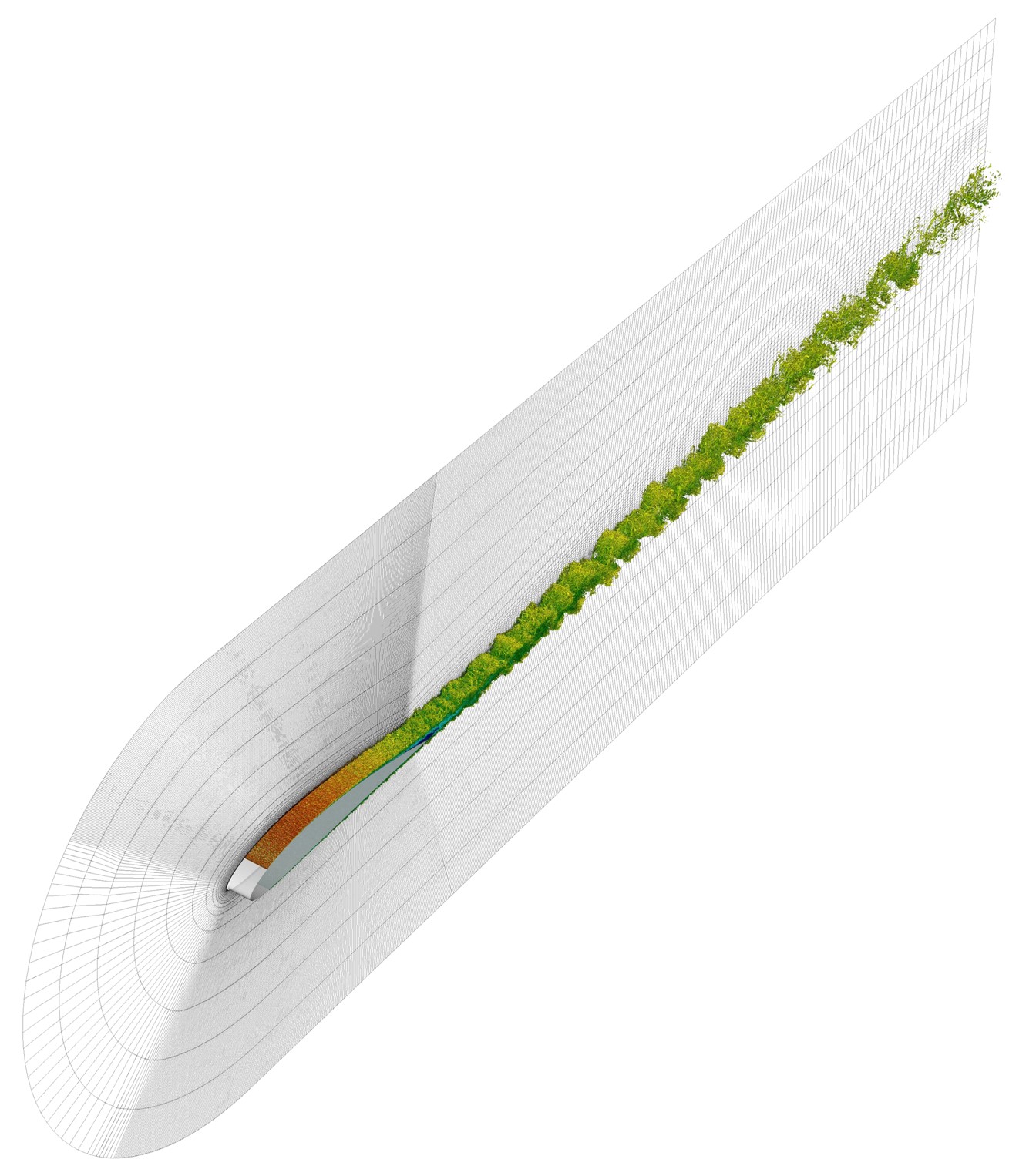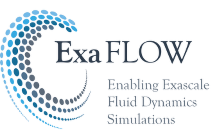Work Package 1: Algorithms
-
Deliverable 1.1 - Internal report on formulation of ExaFLOW algorithms
-
Deliverable 1.2 - Initial proof-of-concept formulation of ExaFLOW algorithms
- Deliverable 1.3 - Final report on ExaFLOW algorithmic developments
Work Package 2: Implementation
-
Deliverable 2.1 - Initial Report on Exascale Technology State-of-the-Art
-
Deliverable 2.2 - Initial Report on the ExaFLOW Algorithms, Energy Efficiency and IO Strategies
-
Deliverable 2.3 – Final report on exascale technology state-of-the-art
-
Deliverable 2.4 – Final report on the ExaFLOW algorithms, energy efficiency and IO strategies
-
Deliverable 2.5 – Release of ExaFLOW CFD algorithms.
Work Package 3: Validation and Use Cases
-
Deliverable 3.1 - Detailed Description of Use Cases and their Requirements
-
Deliverable 3.2 - Use Case Perspective of Algorithmic Developments
-
Deliverable 3.3 - Validation Report on Flagship Applications
-
Deliverable 3.4 – Evaluation from an Industry Perspective with an Industrial Use Case
Work Package 4: Dissemination and Exploitation
-
Deliverable 4.1 - Exploitation Plan
-
Deliverable 4.2 - Exploitation Plan Revision 1
-
Deliverable 4.3 – Exploitation Plan Revision 2 - Contains:
-
Deliverable 4.5 – Innovation Management Report Revision
-
Deliverable 4.8 – Dissemination and Communication – Activities and Results – Update 2
-
Deliverable 4.11 – Collaboration Report – Update 2
-
-
Deliverable 4.4 - Innovation Management Report
-
Deliverable 4.6 - Dissemination and Communication – Initial Plan
-
Deliverable 4.7 - Dissemination and Communication Activities and Results
-
Deliverable 4.9 - Collaboration Report
-
Deliverable 4.10 - Collaboration Report Update 1
Work Package 5: Management
-
Deliverable 5.1 - Management Plan
-
Deliverable 5.2 - Quality Assurance Plan
- Details
- Written by Lena Bühler
- Category: Project Description
- Hits: 18438
2018
-
Otero, E., Vinuesa, R., Marin, O., Laure, E., & Schlatter, P. (2018). Lossy data compression effects on wall-bounded turbulence: bounds on data reduction. Flow, Turbulence and Combustion, 1-23. doi: https://doi.org/10.1007/s10494-018-9923-5
-
Zauner, M., Jacobs, C. T., & Sandham, N. D. (2018). Grid refinement using spectral error indicators with application to airfoil DNS. In Proceedings of the 6th European Conference on Computational Mechanics (ECCM 6) and 7th European Conference on Computational Fluid Dynamics (ECFD 7), 11-15 June 2018, Glasgow, UK. Link: http://congress.cimne.com/eccm_ecfd2018/admin/files/filePaper/p315.pdf
-
Jammy, S. P., Jacobs, C. T., Lusher, D. J., & Sandham, N. D. (2018). Energy consumption of algorithms for solving the compressible Navier-Stokes equations on CPU's, GPU's and KNL's. In Proceedings of the 6th European Conference on Computational Mechanics (ECCM 6) and 7th European Conference on Computational Fluid Dynamics (ECFD 7), 11-15 June 2018, Glasgow, UK. Link: http://congress.cimne.com/eccm_ecfd2018/admin/files/filePaper/p1912.pdf
-
Cantwell, C. D., & Nielsen, A. S. (2018). A Minimally Intrusive Low-Memory Approach to Resilience for Existing Transient Solvers. Journal of Scientific Computing, 1-17. doi: https://doi.org/10.1007/s10915-018-0778-7
-
Eichstädt, J., Green, M., Turner, M., Peiró, J., & Moxey, D. (2018). Accelerating high-order mesh optimisation with an architecture-independent programming model. Computer Physics Communications, 229, 36-53. doi: 10.1016/j.cpc.2018.03.025
-
Jacobs, C. T., Zauner, M., De Tullio, N., Jammy, S. P., Lusher, D. J., & Sandham, N. D. (In Press). An error indicator for finite difference methods using spectral techniques with application to aerofoil simulation. Computers & Fluids. doi: https://doi.org/10.1016/j.compfluid.2018.03.065
-
Lusher, D. J., Jammy, S. P., & Sandham, N. D. (In Press). Shock-wave/boundary-layer interactions in the automatic source-code generation framework OpenSBLI. Computers & Fluids. doi: https://doi.org/10.1016/j.compfluid.2018.03.081
-
Zauner, M., Jacobs, C. T., & Sandham, N. D. (2018). Grid refinement using spectral error indicators with application to airfoil DNS. In Proceedings of the 6th European Conference on Computational Mechanics (ECCM 6) and 7th European Conference on Computational Fluid Dynamics (ECFD 7), 11-15 June 2018, Glasgow, UK. Link: http://congress.cimne.com/eccm_ecfd2018/admin/files/filePaper/p315.pdf
-
Jammy, S. P., Jacobs, C. T., Lusher, D. J., & Sandham, N. D. (2018). Energy consumption of algorithms for solving the compressible Navier-Stokes equations on CPU's, GPU's and KNL's. In Proceedings of the 6th European Conference on Computational Mechanics (ECCM 6) and 7th European Conference on Computational Fluid Dynamics (ECFD 7), 11-15 June 2018, Glasgow, UK. Link: http://congress.cimne.com/eccm_ecfd2018/admin/files/filePaper/p1912.pdf
-
Eichstädt, J., Green, M., Turner, M., Peiró, J., & Moxey, D. (2018). Accelerating high-order mesh generation with an architecture-independent programming model. Computer Physics Communications. doi: https://doi.org/10.1016/j.cpc.2018.03.025
2017
-
Turner, M., Moxey, D., Peiró, J., Gammon, M., Pollard, C. R., & Bucklow, H. (2017). A framework for the generation of high-order curvilienar hybrid meshes for CFD simulations, in Procedia Engineering, 2017, 203, pp. 206–218. doi: 10.1016/j.proeng.2017.09.808
-
Turner, M., Peiró, J., & Moxey, D. (2017). Curvilinear mesh generation using a variational framework. Computer-Aided Design. doi: 10.1016/j.cad.2017.10.004
-
Offermans, N. (2017). Towards adaptive mesh refinement in Nek5000 (Doctoral dissertation, KTH Royal Institute of Technology). Download here.
-
Vymazal, M., Moxey, D., Cantwell, C., Sherwin, S., & Kirby, M. (2017). Towards combined cg-dg for elliptic problems. In SIAM 2017, 2017. Find abstract here.
-
Sandham, N. D., Johnstone, R., & Jacobs, C. T. (2017) Surface-sampled simulations of turbulent flow at high Reynolds number. International Journal for Numerical Methods in Fluids, Accepted. doi: http://dx.doi.org/10.1002/fld.4395
-
Jacobs, C. T., Jammy, S. P., & Sandham, N. D. (2017). OpenSBLI: A framework for the automated derivation and parallel execution of finite difference solvers on a range of computer architectures. Journal of Computational Science, 18:12-23, doi: http://doi.org/10.1016/j.jocs.2016.11.001
-
Jacobs, C., Sandham, N., & De Tullio, N. (2017). An error indicator for finite difference methods using spectral techniques with application to aerofoil simulation At 29th International Conference on Parallel Computational Fluid Dynamics, Glasgow, United Kingdom. 15 - 17 May 2017. 2 pp. Find ext. abstract here.
-
Jacobs, C. T., Jammy, S. P., Lusher, D. J., & Sandham, N. D. (2017). KNL Performance Comparison: OpenSBLI. ARCHER technical report.
-
Jammy, S. P., Jacobs, C. T., Lusher, D. J., & Sandham, N. D. (Submitted). Energy efficiency of finite difference algorithms on multicore CPUs, GPUs, and Intel Xeon Phi processors. Find Pre-print here
-
Turner, M., Peiró, J., & Moxey, D. (2017). Curvilinear mesh generation using a variational framework, Computer-Aided Design. doi: https://doi.org/10.1016/j.cad.2017.10.004
2016
-
Jammy, S. P., Jacobs, C. T., & Sandham, N. D. (2016). Performance evaluation of explicit finite difference algorithms with varying amounts of computational and memory intensity, J. Comput. Sci. (2016), http://dx.doi.org/10.1016/j.jocs.2016.10.015
-
Bareford, M., Johnson, N., & Weiland, M. On the trade-offs between energy to solution and runtime for real-world CFD test-cases. In Proceedings of the Exascale Applications and Software Conference 2016 (EASC '16). ACM, New York, NY, USA, Article 6, 8 pages. doi: http://dx.doi.org/10.1145/2938615.2938619
-
Moxey, D., Cantwell, C. D., Mengaldo, G., Serson, D., Ekelschot, D., Peiró, J., Sherwin, S. J., & Kirby, R. M. Towards p-adaptive spectral/hp element methods for modelling industrial flows, International Conference on Spectral and High-Order Methods, 2016. Find abstract here.
-
Sherwin, S., Lombard, J.-E., Moxey, D., Moura, J. P. R., & Mengaldo, G. Implicit les spectral/hp element modelling of flow past complex geometries related to formula 1, International Conference on Spectral and High-Order Methods, 2016. Find abstract here.
-
Nielsen, A. S., & Hesthaven, J. S. (2016). Fault Tolerance in the Parareal Method. Proceedings of the Fault Tolerance for HPC at eXtreme Scale Workshop at the 25th ACM Symposium on High-Performance Parallel and Distributed Computing. doi: 10.1145/2909428.2909431
-
Offermans, N., Marin, O., Schanen, M., Gong, J., Fischer, P., & Schlatter, P. On the Strong Scaling of the Spectral Element Solver Nek5000 on Petascale Systems. In Proceedings of the Exascale Applications and Software Conference 2016. doi: https://doi.org/10.1145/2938615.2938617
-
Peplinski, A., Fischer, P. F., & Schlatter, P. (2016, April). Parallel performance of h-type Adaptive Mesh Refinement for Nek5000. In Proceedings of the Exascale Applications and Software Conference 2016 (p. 4). doi: 10.1145/2938615.2938620
- Details
- Written by Lena Bühler
- Category: Project Description
- Hits: 21331
Download material on "ExaFLOW use case for SBLI: numerical simulation of the compressible flow over a NACA-4412 airfoil at incidence"
Wing profile NACA4412 in incompressible flow: The flow over aircraft wings is, for obvious reasons, a very important use case for any type of scale-resolved numerical simulation. The improved understanding of the complex physical behaviour of the turbulence will pave the way to improved engineering design, including:
i) reduced air resistance and thus lower fuel consumption,
ii) increased robustness of wings with respect to external influences such as atmospheric turbulence, high angles of attack, icing,
iii) improved wing characteristics such as lower landing speeds,
iv) better flow quality along the wing and thus more effective control surfaces.
The flow along an airfoil is subject to a number of highly relevant and only partially understood physical phenomena; transition to turbulence close to the leading edge, turbulent boundary layers under adverse and favourable pressure gradients, potential flow separation close to the trailing edge, and finally free turbulence in the wake. All these aspects have so far only been studied in isolated test cases, and shall now be put together into one case, where their interaction is investigated. The high Reynolds number characteristic of airfoil flows poses another difficulty, in particular because there are clear differences between the flow at low Reynolds number and higher ones; therefore, any upscaling method is bound to fail.
For the present use case, we will consider an idealised NACA4412 wing profile, which is a generic geometry frequently used as an industrial and academic test case to validate simulation and experimental methods. The spanwise direction will initially be based on periodic boundary conditions, but at a later stage will be supplemented with wing tips, which will allow us to study end effects (note that this region is crucial when it comes to drag reduction of wings). Looking toward exascale computing (and further) the challenge is to run this sort of test case at Reynolds numbers of O(106-107), with different approaches including DNS, LES with resolved near-wall layers and LES with wall models (including heterogeneous models as discussed in the proposal).
To study fundamental aspects of fluid turbulence at low speeds, in particular in complex geometries, the incompressible approximation has a number of both numerical and physical advantages. For the present case, we will use Nek5000 to simulate the airflow along a wing section; such a resolved DNS will require about 10-100 billion grid points. The adaptive mesh strategy will thus be of particular importance in the turbulent wake of the airfoil where little information about the flow is known.
The proposed simulations will be compared with planned experiments in the KTH wind tunnel at comparable Reynolds numbers.

Figure 1: Turbulent structures extracted from the incompressible NACA4412 wing case
NACA4412 in compressible flow: In this use case we adopt the NACA4412 airfoil in compressible subsonic flow. In the compressible flow case exhibits aspects of hyperbolic behaviour and sustains sound waves that are not resolved in incompressible flows. This change leads to very different numerical algorithms, since the divergence-free constraint on the velocity is removed. It is important to assess the scaling to exa-scale for such cases to compare the requirements with those of incompressible flow. The compressible flow solution include the acoustic field, making possible predictions of the aeroacoustic properties of airfoils. The use case considers a representative airfoil showing laminar separation, vortex shedding and sound generation from the trailing edge. The objective of the numerical approach is to efficiently resolve both the hydrodynamic near field and the acoustic far field, which have different grid requirement. The use case contains an example of initially two-dimensional flow with a variable spanwise extent that can be adjusted to consider strong and weak scaling.

Figure 2: Instantaneous contours of spanwise vorticity from a simulation of air flow past a NACA-4412 airfoil
CODES USED: Nek5000, SBLI
- Details
- Written by Anna Palaiologk
- Category: Project Description
- Hits: 19904
The main goal of ExaFLOW is to address key algorithmic challenges in CFD (Computational Fluid Dynamics) to enable simulation at exascale, guided by a number of use cases of industrial relevance, and to provide open-source pilot implementations.
The project comprises of the following 5 use cases:
- McLaren Front Wing run by Imperial College London and McLaren Racing
- Wing profile NACA4412 run by KTH Stockholm and the University of Southampton
- Automotive run by the Automotive Simulation Center Stuttgart
- Jet in crossflow run by KTH Stockholm and the University of Stuttgart
- Details
- Written by Anna Palaiologk
- Category: Project Description
- Hits: 32956



